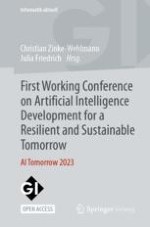1 Introduction
2 Methodology
3 State of the Art
3.1 Comparison of Existing Models
Approach | Description | Strengths | Weaknesses | Optimization potential |
|---|---|---|---|---|
Human-Centered AI Design [cf. 4] | refers to integration of HCD principles into development of AI systems; AI systems must consider the needs, abilities, perspectives of users to ensure suitability for human use; helps to make AI systems more effective and user-friendly | increased user trust and acceptance; improved usability and accessibility; reduced bias and discrimination | requires significant expertise and resources; possibility of ethical trade-offs | integration of user feedback throughout the AI development process; ongoing evaluation and refinement of AI systems |
AI-Supported Human-Centered Design [cf. 7] | assistance in carrying out tasks within scope of HCD; AI may help analyze user data and identify patterns to gain a better under-standing of user needs; AI may aid in generating design options and prototypes to accelerate and enhance design process | better efficiency and accuracy in data analysis; increased design innovation and creativity | dependent on data quality and availability; risk of over-reliance on AI-generated insights | development of transparent and interpretable AI models; collaboration to ensure balance between human and AI insights |
AI-Driven Human-Centered Design [cf. 28] | AI as direct role in HCD by being incorporated as part of design itself; may be used for product/service personalization and recommending individual customization; may improve user experience by analyzing interactions between users and products/services and adjusting user needs and preferences | increased speed and scalability of design processes; ability to process large and complex data sets | possibility of reduced human input and creativity; risk of designing for the AI rather than for the user | integration of user feedback and HCD principles in the AI development process; regular evaluation of the impact of AI on the design process |
Ethics-Based Human-Centered Design [cf. 25] | integration of ethical considerations into HCD; ensure that AI systems are human-centered and ethically sound; includes consideration of multiple factors (privacy, discrimination, fairness in development of AI systems; may lead to creation of AI systems that are conform to ethical standards | higher trust and social responsibility; alignment with regulatory requirements and ethical standards | potential for conflicting ethical values and perspectives; need for expert guidance in ethical decision-making | integration of multiple perspectives and stakeholder input; ongoing evaluation of ethical implications throughout the design process |
